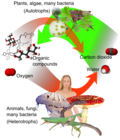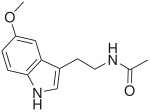 | Phototrophs (from Ancient Greek φῶς, φωτός (phôs, phōtós) 'light', and τροφή (trophḗ) 'nourishment') are organisms that carry out photon capture to produce... 8 KB (737 words) - 01:11, 6 August 2023 |
Chloroflexota (redirect from Filamentous anoxygenic phototrophs) thermophiles, which use oxygen and grow well in high temperatures; anoxygenic phototrophs, which use light for photosynthesis (green non-sulfur bacteria); and... 38 KB (2,640 words) - 04:50, 23 February 2024 |
 | Global oceanic and terrestrial phototroph abundance, from September 1997 to August 2000. As an estimate of autotroph biomass, it is only a rough indicator... 47 KB (5,437 words) - 03:18, 3 March 2024 |
= light, hetero = (an)other, troph = nourishment) are heterotrophic phototrophs—that is, they are organisms that use light for energy, but cannot use... 20 KB (2,138 words) - 18:04, 3 December 2023 |
 | Some cyanobacteria are also capable of nitrogen fixation. These are phototrophs, which carry out photosynthesis. Like other nitrogen-fixing bacteria... 63 KB (6,905 words) - 15:25, 17 February 2024 |
inorganic (chemolithotrophs). The chemotroph designation is in contrast to phototrophs, which use photons. Chemotrophs can be either autotrophic or heterotrophic... 8 KB (816 words) - 03:47, 27 April 2024 |
 | RuBisCO is thought to be the single most abundant protein on Earth. Phototrophs use the products of their photosynthesis as internal food sources and... 112 KB (12,908 words) - 19:59, 24 April 2024 |
 | different heterotrophs is by assigning them as chemotrophs or phototrophs. Phototrophs utilize light to obtain energy and carry out metabolic processes... 27 KB (2,935 words) - 20:11, 6 April 2024 |
of distribution, lithotrophs may actually outnumber organotrophs and phototrophs in our biosphere. The use of inorganic electron donors such as hydrogen... 33 KB (4,063 words) - 12:57, 22 April 2024 |
photopic, photoptarmosis, photosynthesis, phototaxis, phototherapy, phototroph, telephoto phrag- (ΦΡΑΓ) fence Greek φράσσειν (phrássein), φράξις (phráxis)... 2 KB (1,764 words) - 06:15, 16 April 2024 |
 | Other groups of archaea use sunlight as a source of energy (they are phototrophs), but oxygen–generating photosynthesis does not occur in any of these... 155 KB (16,478 words) - 20:04, 25 April 2024 |
PMC 3566065. PMID 23405255. Gallon JR (1 March 2001). "N2 fixation in phototrophs: adaptation to a specialized way of life". Plant and Soil. 230 (1): 39–48... 46 KB (4,916 words) - 12:21, 26 April 2024 |
 | (August 2019). "The trouble with oxygen: The ecophysiology of extant phototrophs and implications for the evolution of oxygenic photosynthesis". Free... 109 KB (11,576 words) - 21:44, 26 April 2024 |
Ochromonas tuberculata may invade and suppress specialist phago- and phototroph plankton communities depending on nutrient conditions". Oecologia. 148... 18 KB (1,679 words) - 13:14, 5 January 2024 |
 | part) and purple non-sulfur bacteria. Purple bacteria are anoxygenic phototrophs widely spread in nature, but especially in aquatic environments, where... 30 KB (3,674 words) - 16:36, 4 December 2023 |
 | seen in dinoflagellates: phototrophy, mixotrophy, and heterotrophy. Phototrophs can be photoautotrophs or auxotrophs. Mixotrophic dinoflagellates are... 95 KB (10,290 words) - 15:54, 5 February 2024 |
 | Organotrophs Photoheterotrophs Photosynthesis Photosynthetic efficiency Phototrophs Primary nutritional groups Primary production Consumers Apex predator... 83 KB (8,618 words) - 00:25, 11 March 2024 |
 | phycobilisomes. Prochlorococcus is the only known wild-type oxygenic phototroph that does not contain Chl a as a major photosynthetic pigment, and is... 37 KB (3,696 words) - 08:20, 25 April 2024 |
community. Aerobic anoxygenic phototrophic bacteria are photoheterotrophic (phototroph) microbes that exist in a variety of aquatic environments. Most are obligately... 14 KB (1,842 words) - 12:27, 13 September 2023 |
 | Ochromonas tuberculata may invade and suppress specialist phago- and phototroph plankton communities depending on nutrient conditions". Oecologia. 148... 76 KB (7,030 words) - 05:39, 28 April 2024 |
 | becomes anoxic towards the interface of the mud and water. Anaerobic phototrophs are still present to a large extent in the mud phase, and there is still... 5 KB (616 words) - 18:58, 2 March 2024 |
photosynthetic pigment, bacteriochlorophyll g and are the only known Gram-positive phototroph. They are a key player in symbiotic nitrogen fixation alongside plants... 10 KB (939 words) - 09:17, 15 February 2023 |
anaerobic respiration, or various metabolic intermediates in fermentation. Phototrophs absorb light in photoreceptors and transform it into chemical energy... 19 KB (1,616 words) - 12:21, 22 January 2024 |






